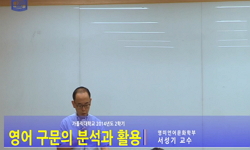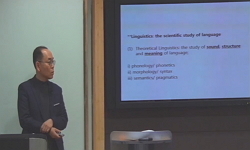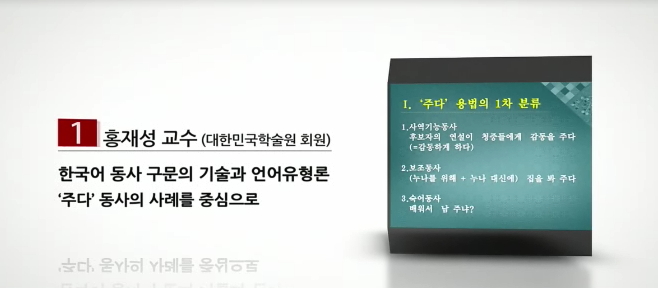[Purpose] This study aimed to examine the syntactic ability of third and fourth graders with and without vocabulary delay from multicultural families in retelling of comparison and causation expository discourses. [Method] The participants were 15 chi...
http://chineseinput.net/에서 pinyin(병음)방식으로 중국어를 변환할 수 있습니다.
변환된 중국어를 복사하여 사용하시면 됩니다.
- 中文 을 입력하시려면 zhongwen을 입력하시고 space를누르시면됩니다.
- 北京 을 입력하시려면 beijing을 입력하시고 space를 누르시면 됩니다.

초등 3-4학년 다문화가정 어휘발달지연아동과 일반아동의 비교대조와 원인결과 설명담화 다시 말하기에 나타난 구문 특성 = The Syntactic Ability of Third and Fourth Graders with and without Vocabulary Delay from Multicultural Families: in Retelling of Comparison and Causation Expository Discourses
한글로보기https://www.riss.kr/link?id=A107991540
- 저자
- 발행기관
- 학술지명
- 권호사항
-
발행연도
2021
-
작성언어
-
- 주제어
-
KDC
300
-
등재정보
KCI등재
-
자료형태
학술저널
- 발행기관 URL
-
수록면
155-174(20쪽)
-
KCI 피인용횟수
0
- DOI식별코드
- 제공처
-
0
상세조회 -
0
다운로드
부가정보
다국어 초록 (Multilingual Abstract)
[Purpose] This study aimed to examine the syntactic ability of third and fourth graders with and without vocabulary delay from multicultural families in retelling of comparison and causation expository discourses. [Method] The participants were 15 children with vocabulary delay and 15 children without vocabulary delay, all of whom were from multicultural families, and 15 children without vocabulary delay from non-multicultural families. All the children were asked to retell two expository discourses after listening to them with pictures. The total number of T-units as syntactic productivity, the number of morphemes per T-unit, and the number of subordinate clauses as syntactic complexity were analyzed. [Results] The results showed that there were no differences between the three groups in the total number of T-units. However, children with vocabulary delay from multicultural families had significantly fewer morphemes per T-unit and subordinate clauses as syntactic complexity than the two groups of children without vocabulary delay. What is more, children were likelier to retell longer and more complex sentences about causation expository discourses when compared to the retelling of comparison expository discourses. [Conclusion] The results demonstrate that children with vocabulary delay from multicultural families are likely to make shorter and less complex sentences in expository discourses than children without vocabulary delay. The types of expository discourses should be considered in language assessment and intervention.
참고문헌 (Reference)
1 조아라, "한국어 어휘 능력에 따른 다문화 가정 아동과 일반 가정 아동의 이야기 산출 및 이해 능력 비교" 이화여자대학교 대학원 2011
2 박미단, "학령전기 다문화가정 아동과 일반아동의 언어발달 특성 비교" 나사렛대학교 재활복지대학원 2009
3 김민정, "학령기 아동과 청소년의 명사발달 : 명사 수준 분석을 중심으로" 나사렛대학교 재활복지대학원 2011
4 김미진, "학령기 다문화가정 아동의 설명글 쓰기 특성" 단국대학교 대학원 2013
5 황소진, "학령기 다문화가정 아동과 일반가정 아동 간의 구문표현능력 비교 : 설명담화를 중심으로" 단국대학교 특수교육대학원 2010
6 김화수, "학년에 따른 학령기 다문화가정아동과 일반가정아동의 생성이름대기 특성 비교" 한국특수교육문제연구소 10 (10): 331-360, 2009
7 김영란, "취학전 저소득층 다문화가정 아동의 언어능력" 한국언어치료학회 20 (20): 73-88, 2011
8 장종윤, "초등학교 저학년 다문화가정 아동의 동음이의어 이해와 정의하기" 한국언어청각임상학회 19 (19): 71-79, 2014
9 황다정, "초등학교 2-3학년 다문화가정 아동의 전제 의미 추론 능력" 특수교육연구소 18 (18): 257-271, 2019
10 배소영, "초등 저학년 다문화가정 아동의 읽기와 언어" 한국언어청각임상학회 15 (15): 146-156, 2010
1 조아라, "한국어 어휘 능력에 따른 다문화 가정 아동과 일반 가정 아동의 이야기 산출 및 이해 능력 비교" 이화여자대학교 대학원 2011
2 박미단, "학령전기 다문화가정 아동과 일반아동의 언어발달 특성 비교" 나사렛대학교 재활복지대학원 2009
3 김민정, "학령기 아동과 청소년의 명사발달 : 명사 수준 분석을 중심으로" 나사렛대학교 재활복지대학원 2011
4 김미진, "학령기 다문화가정 아동의 설명글 쓰기 특성" 단국대학교 대학원 2013
5 황소진, "학령기 다문화가정 아동과 일반가정 아동 간의 구문표현능력 비교 : 설명담화를 중심으로" 단국대학교 특수교육대학원 2010
6 김화수, "학년에 따른 학령기 다문화가정아동과 일반가정아동의 생성이름대기 특성 비교" 한국특수교육문제연구소 10 (10): 331-360, 2009
7 김영란, "취학전 저소득층 다문화가정 아동의 언어능력" 한국언어치료학회 20 (20): 73-88, 2011
8 장종윤, "초등학교 저학년 다문화가정 아동의 동음이의어 이해와 정의하기" 한국언어청각임상학회 19 (19): 71-79, 2014
9 황다정, "초등학교 2-3학년 다문화가정 아동의 전제 의미 추론 능력" 특수교육연구소 18 (18): 257-271, 2019
10 배소영, "초등 저학년 다문화가정 아동의 읽기와 언어" 한국언어청각임상학회 15 (15): 146-156, 2010
11 하승희, "자발화 분석을 통한 만 2세 한국아동의 말-언어발달 특성" 한국언어청각임상학회 21 (21): 47-59, 2016
12 정종성, "읽기장애 발생의 주요 변인으로서의 텍스트 장르에 대한 분석: 초등학교 읽기 교과서를 중심으로" 한국아동교육학회 19 (19): 245-257, 2010
13 임종아, "이야기다시말하기에서 나타난 ADHD아동의 mazes 특성" 한국언어청각임상학회 14 (14): 95-107, 2009
14 안혜령, "여성결혼이민자 가정 아동과 일반 가정 아동의 학업성취 비교" 한국아동학회 30 (30): 1-10, 2009
15 김정아, "언어발달장애 청소년의 과제유형에 따른 이야기 담화능력 비교" 이화여자대학교 대학원 2009
16 김영태, "언어결핍환경 아동의 어휘 발달 특성- 다문화가정과 청각장애부모가정 아동을 중심으로 -" 한국언어치료학회 22 (22): 17-39, 2013
17 배승아, "수용어휘 수준에 따른 다문화가정 아동과 일반가정 아동의 표현어휘 및 구문 오류 특성 연구" 이화여자대학교 대학원 2012
18 김정수, "설명하는 말하기의 단계별 지도 프로그램 연구" 부산교육대학교 교육대학원 2004
19 김화수, "단순언어장애 아동의 통사처리능력" 한국특수교육문제연구소 12 (12): 93-111, 2011
20 김효정, "다문화언어 환경 아동의 수용 및 표현어휘능력" 한림대학교 보건대학원 2008
21 최현욱, "다문화가정 이주여성의 한국어능력이 자녀의 한국어능력 발달에 미치는 영향" 한국특수교육문제연구소 10 (10): 315-329, 2009
22 정은희, "농촌지역 국제결혼 가정 아동의 언어 발달과 언어 환경" 한국언어치료학회 13 (13): 33-52, 2004
23 장세영, "국내 다문화가정 아동대상의 언어중재관련 문헌분석 연구" 한국특수교육문제연구소 21 (21): 33-56, 2020
24 Kim, K. H., "Vocabulary of Korean Education by Grade" Pagijong 2003
25 Kim, S. H., "The syntactic characteristics in retelling of the expository discourse types in second, fourth, and sixth grade children" Chosun University 2018
26 Hoff-Ginsberg, E., "The relation of birth order and socioeconomic status to children’s language experience and language development" 19 : 603-630, 1998
27 Williams, J. P., "Teaching expository text structure to young at-risk learners : Building the basics of comprehension instruction" 12 (12): 129-144, 2004
28 Sim, S. M., "Syntactic Awareness Skills of 2nd and 3rd Grades of Elementary School Students from Multi-cultural Families" Dankuk University 2018
29 Merritt, D. D., "Story grammar ability in children with and without language disorder: Story generation, story retelling, and story comprehension" 30 : 539-553, 1987
30 Marleen, F, W., "Spoken expository discourse of children and adolescents: Retelling versus generation" 1-15, 2013
31 Kwon, J. I., "Research of the vocabulary of textbooks for elementary school" National Institute of Korean Language 2009
32 Kim, Y. T., "Receptive and expressive vocabulary test (REVT)" Seoul Community Rehabilitation Center 2009
33 Oakhill, J., "Reading comprehension difficulties" Lawrence Erlbaum Associates 69-92, 1996
34 Pae, S. Y, "Read and speak together" Ministry of Gender Equality and Family 2010
35 Nippold, M. A., "Peer conflict explanations in children, adolescents, and adults: Examining the development of complex syntax" 16 : 179-188, 2007
36 "National Curriculum Information Center"
37 "Ministry of Education"
38 Scott, C. M., "Measures of syntax in school age children and adolescents" 26 : 309-319, 1995
39 Ward-Lonergan, J. M., "Listening comprehension and recall abilities in adolescents with language-learning disabilities and without disabilities for social studies lectures" 32 (32): 213-223, 1998
40 Leadholm, B. J., "Language sample analysis: The wisconsin guide" Wisconsin Department of Public Instruction 1992
41 Scott, C. M., "Language learning disabilities in school-age children and adolescents" Merrill 210-252, 1994
42 Loban, W., "Language development: Kindergarten through grade twelve" National Council of Teachers of English 1976
43 Park, H. W., "Korean version of Comprehensive Test of Nonverbal Intelligence-second edition (K-CTONI-2)" Mindpress 2014
44 "Korean Statistical Information Service"
45 Korean Statistics Research Institute, "Korean Social Trends 2019"
46 Scott, C. M., "General language performance measures in spoken and written narrative and expository discourse of school age children with language learning disabilities" 43 : 324-339, 2000
47 Francis, W., "Frequency of analysis of English usage: Lexicon and grammar" Allyn & Bacon 1982
48 Saenz, L. M., "Examining the reading difficulty of secondary students with learning disabilities : Expository versus narrative text" 23 (23): 31-41, 2002
49 Nippold, M. A., "Conversational versus expository discourse a study of syntactic development in children, adolescents, and adults" 48 : 1049-1064, 2005
50 Nippold, M. A., "Conversational and narrative speaking in adolescents: Examining the use of complex syntax" 57 : 876-886, 2014
51 Bishop, D. V. M., "Comprehension problem in children with specific language impairment : Literal and inferential meaning" 35 : 119-129, 1992
52 Glenberg, A. M., "Comprehension of illustrated text : Pictures help to build mental models" 31 (31): 129-151, 1992
53 Lee, M. L., "Characteristics of the type of spoken expository discours in school-aged children with language learning disability" Catholic University of Pusan 2014
54 Kang, M. K., "Characteristics of the retelling of expository discourses by children from multicultural families according to a picture presentation condition: Focused on mazes" Dankuk University 2015
55 Richagels, D. J., "Awareness of four text structures : Effects on recall of expository text" 22 : 177-196, 1987
56 Kim, Y. T., "Assessment and treatment of language disordered children" Hakjisa 2014
57 Brown, R., "A first language : The early stages" Harvard University Press 1973
58 임애리, "10대 초반 학생의 표현 언어에서 나타난 구문 발달 양상" 연세대학교 대학원 2003
59 윤혜련, "'다시말하기'를 통해 본 학령기 단순언어장애아동의 이야기 이해 및 산출 특성" 이화여자대학교 대학원 2005
동일학술지(권/호) 다른 논문
-
- 대구대학교 한국특수교육문제연구소
- 이학준 ( Lee Hak-jun )
- 2021
- KCI등재
-
장애유아를 위한 음악중재의 내용과 효과크기검증 문헌분석 -2005-2020년 국내 학술지논문 중심으로-
- 대구대학교 한국특수교육문제연구소
- 서보순 ( Seo Bo-soon )
- 2021
- KCI등재
-
유치원 통합학급 내 특수교사 배치 유형에 따른 유치원교사와 특수교사의 통합교육 인식 및 만족도 비교
- 대구대학교 한국특수교육문제연구소
- 박찬웅 ( Park Chan Woong )
- 2021
- KCI등재
-
특수학교의 긍정적 행동중재와 지원(PBIS)에 관한 특수교사의 경험과 지원요구: 포커스 그룹 인터뷰(FGI)를 중심으로
- 대구대학교 한국특수교육문제연구소
- 강영모 ( Kang Youngmo )
- 2021
- KCI등재
분석정보
인용정보 인용지수 설명보기
학술지 이력
| 연월일 | 이력구분 | 이력상세 | 등재구분 |
|---|---|---|---|
| 2027 | 평가예정 | 재인증평가 신청대상 (재인증) | |
| 2021-01-01 | 평가 | 등재학술지 유지 (재인증) |  |
| 2018-01-01 | 평가 | 등재학술지 유지 (등재유지) |  |
| 2015-02-04 | 학회명변경 | 한글명 : 대구대학교 한국특수교육문제연구소 -> 한국특수교육문제연구소영문명 : Daegu University Research Institute of the Korea Special Education -> Research Institute of the Korea Special Education |  |
| 2015-01-01 | 평가 | 등재학술지 유지 (등재유지) |  |
| 2014-05-23 | 학회명변경 | 한글명 : 한국특수교육문제연구소 -> 대구대학교 한국특수교육문제연구소영문명 : Research Institute of the Korean Special Education -> Daegu University Research Institute of the Korea Special Education |  |
| 2011-01-01 | 평가 | 등재학술지 유지 (등재유지) |  |
| 2009-01-01 | 평가 | 등재학술지 유지 (등재유지) |  |
| 2006-08-16 | 학회명변경 | 한글명 : BK21특수교육교육연구단 -> 한국특수교육문제연구소영문명 : Bk21 Project Force Of Special Education -> Research Institute of the Korean Special Education |  |
| 2006-06-22 | 학술지명변경 | 한글명 : 특수교육저널: 이론과 실천 -> 특수교육저널:이론과 실천 |  |
| 2006-05-18 | 학회명변경 | 한글명 : BK21특수교육교육연구단 -> 대구대학교 대학원 특수교육학과영문명 : Bk21 Project Force Of Special Education -> Daegu University Graduate School of Special Education |  |
| 2006-01-01 | 평가 | 등재학술지 선정 (등재후보2차) |  |
| 2005-01-01 | 평가 | 등재후보 1차 PASS (등재후보1차) |  |
| 2003-01-01 | 평가 | 등재후보학술지 선정 (신규평가) |  |
학술지 인용정보
| 기준연도 | WOS-KCI 통합IF(2년) | KCIF(2년) | KCIF(3년) |
|---|---|---|---|
| 2016 | 1.33 | 1.33 | 1.26 |
| KCIF(4년) | KCIF(5년) | 중심성지수(3년) | 즉시성지수 |
| 1.18 | 1.18 | 1.518 | 0.46 |





 KCI
KCI KISS
KISS






